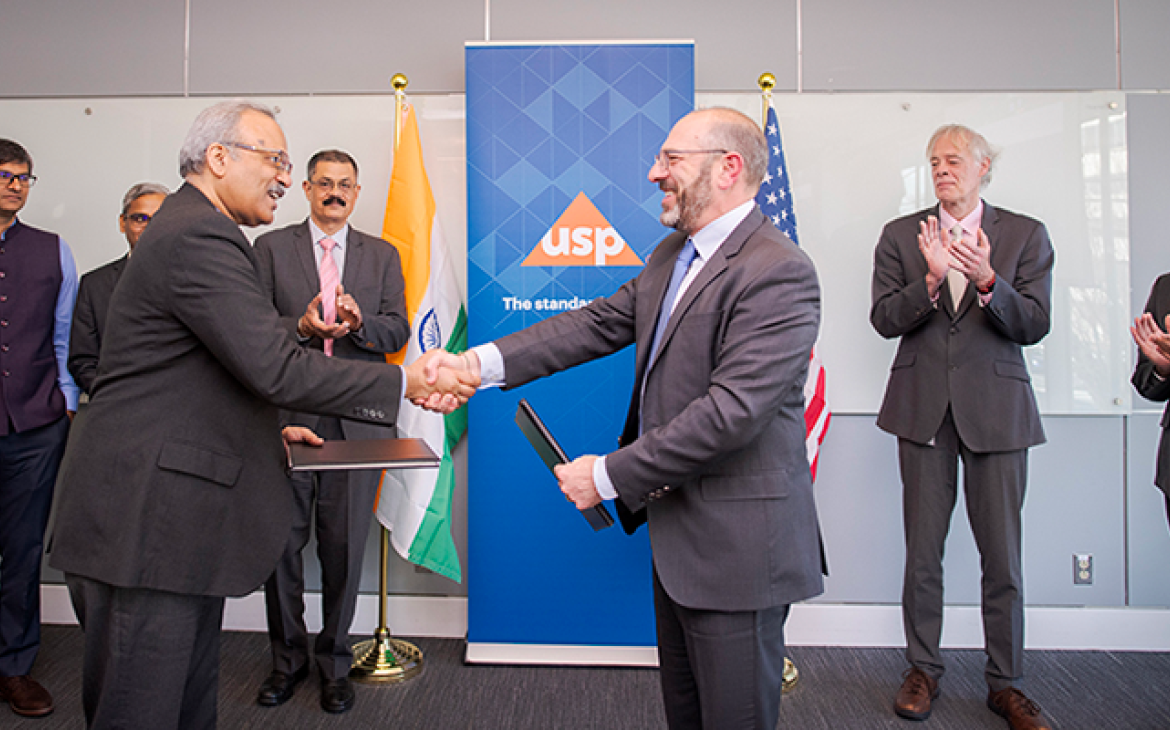
Drug shortages pose a significant, ongoing threat to our healthcare system and to the patients who rely on medicine for their wellbeing and survival. The USP Medicine Supply Map shows that 125 drug products were in shortage at the end of 2023, the highest number in a decade. And shortages are lasting longer than ever, with a 3-year average duration in 2023 compared to 2 years in 2022.
This urgency drove USP and the American Cancer Society Cancer Action Network (ACS CAN) to combine our expertise and insights to develop a set of principles, informed by feedback from a range of healthcare stakeholders, to support a comprehensive and coordinated response to U.S. drug shortages. These principles, co-signed by more than a dozen leading health advocacy organizations who have since formed a Drug Shortage Task Force, underpin a legislative Call to Action. The policy recommendations therein aim to help prevent and mitigate shortages, ensuring that patients have access to the quality medicines they need when they need them.
Momentum toward action is growing. Both the Administration and Congress have given significant attention to this pervasive issue, as recognized in the recent white paper published by the U.S. Department of Health and Human Services (HHS) and in drug shortage hearings in both the Senate and the House. Each chamber has introduced legislation that would implement some urgently needed solutions (for example, S.2364 and H.R.6992, both known as the “Mapping America’s Pharmaceutical Supply (MAPS) Act”). In addition, USP welcomes additional proposals that are intended to address the economic factors that drive disruptions in the supply chain.
In response to this pervasive public health crisis and to maintain momentum toward action, USP and ACS CAN hosted a Congressional briefing in March 2024 to highlight the root causes, complexities, and pervasiveness of drug shortages, as well as the need for urgent and comprehensive solutions. This briefing, widely attended with bipartisan representation, included panel discussions with key thought leaders and experts on the pharmaceutical supply chain to share insights that can help to prevent future shortages and improve access to critical medicines for all patients. Many of the insights and perspectives from this event are reflected in the Call to Action, with specific elements highlighted below:
- Coordinate pharmaceutical supply chain resilience and reliability efforts among federal agencies and non-governmental stakeholders: Coordination among federal agencies and non-governmental stakeholders should involve defining measurable outcome metrics for implementation efforts, and strategic planning activities to maximize the utility of new programs and increase the impact of existing initiatives. Nicolette Louissaint, SVP of Policy and Strategic Planning at the Healthcare Distribution Alliance, noted that the HHS Administration for Strategic Preparedness and Response (ASPR) provided an ideal template for public-private partnerships via its work on the rollout of COVID-19 vaccines. Deb Constien, a patient advocate who lives with chronic rheumatoid arthritis, explained how patients can suffer when coordination falls short. Erratic bulk purchasing by hospitals during the COVID-19 pandemic left Deb unable to access a medication that worked for her body and her chronic symptoms, leaving cycling through less effective alternatives.
- Increase pharmaceutical supply chain visibility by investing in early warning capabilities that signal threats and vulnerabilities: A better understanding of shortage risk factors, and how they may be interrelated, requires a deeper understanding of the supply chain, from raw materials and active pharmaceutical ingredients (APIs) to distribution and administration of drug products to patients. Disruption at any point along the supply chain can impact the availability of treatments that patients rely on for chronic or acute care. This can be particularly complex for certain disease states. For example, Dr. Carolyn Hendricks, an oncologist and active member of the American Society of Clinical Oncology, noted that first-line treatments often aren’t as simple as administering a single drug. Cancer treatments may combine a brand-name or complex drug with a more basic generic counterpart. Increased understanding of the supply chain vulnerabilities for both therapies is important to ensure the continued availability of these life-saving treatments.
- Establish a Vulnerable Medicines List in the U.S., which factors in pharmaceutical supply chain vulnerabilities: A vulnerable drugs list would be continually updated to reflect the likelihood that a particular medicine could go into shortage. This list would ensure that finite resources and investments are focused on where they are most needed to improve medicines supply chain resiliency. Creation and utilization of vulnerable medicines lists will help prioritize the production of needed medicines and target policy and economic interventions and finite resources toward better supply chain resiliency.
- Align the U.S. market to incentivize pharmaceutical supply chain quality, resilience, and reserves for drugs vulnerable to shortages: A fundamental shift in the market for lower-priced drugs can help to align supply and demand forces to create a more predictable, sustainable, and high-quality supply chain. Toward this goal, the Drug Shortage Task Force proposes the adoption of payment and purchasing models that value and incentivize supply chain resilience and reliability. Examples include longer-term, guaranteed-volume contracts, in which prices are assured for a defined, guaranteed volume. Craig Burton, SVP of Policy for the Association for Accessible Medicines, emphasized that “every single drug shortage is impacted by unsustainably low pricing. Low prices “drive manufacturers out of the market and leave supply chains fragile and vulnerable to random shocks, like a tornado knocking out the only manufacturing plant for a critical drug or ingredient.”
- Optimize manufacturing capacity for U.S. drug products through policy reforms that reduce risk of disruptions and shortages: Drugs with greater manufacturing complexity, such as sterile injectables, have an increased vulnerability to shortage, according to Medicine Supply Map data presented at the briefing by USP’s Matt Christian. Enhancing security in the manufacturing base for U.S. drug products can help to reduce the risk of disruptions and shortages. Economic or other incentive measures will encourage multiple suppliers for key drugs and input products, as well as geographic diversification of manufacturing facilities, and manufacturing location and component supply redundancies.
- Research to better understand the root causes of and the market dynamics associated with persistent drug shortages in the U.S.: Impartial, nonpartisan research into the complex market dynamics associated with generic medicines is necessary. Targeted pilots or limited-scale projects can test interventions before scaling more broadly. USP’s Carrie Harney noted in her panel remarks that more granular research and insights can help us “target interventions and allocate resources more effectively” based on the specific vulnerabilities of a given medicine.
The growing momentum to address drug shortages can help build political willpower to enact comprehensive and coordinated solutions. Patients and their families, as well as doctors, nurses, and healthcare providers, urgently await action from policymakers. Whether by analyzing, sharing, or acting on the evidence on what causes shortages and how to prevent them, we all share a responsibility to ensure that patients have access to the medicines they need, when they need them.
USP and the members of the Drug Shortage Task Force are committed to working with both sides of the aisle to enact solutions to this urgent public health issue. We encourage you to support this effort by reading and sharing our Call to Action to get these solutions in front of those who need to see them: https://www.usp.org/sites/default/files/usp/document/supply-chain/call-to-action-on-drug-shortages.pdf
Please also look for the upcoming release of USP’s Annual Drug Shortages Report. Featuring data and insights from USP’s Medicine Supply Map, the report will underscore the significant market and policy interventions that can address worsening drug shortage trends.


